People
‘I Cold-Called Her’: Brooke Shields on Why She Rang Up an Emerging Artist and Volunteered to Model for Her Latest Work
Shields most recently posed, with her daughters, for artist Tara Lewis.
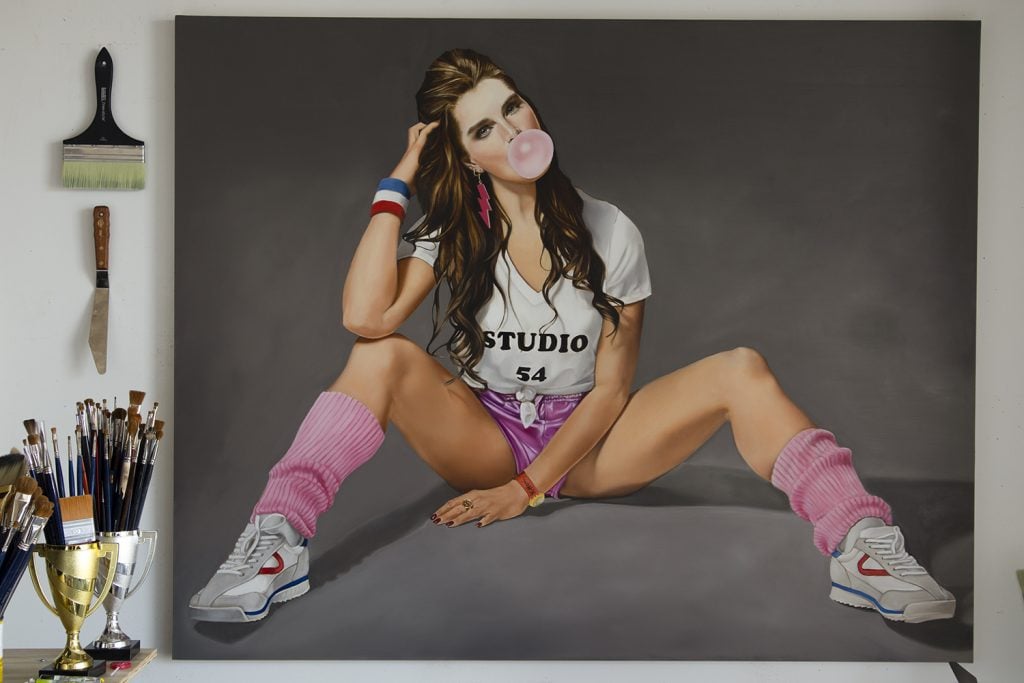
Shields most recently posed, with her daughters, for artist Tara Lewis.

Katie White

Brooke Shields has famously played muse for photographers, from Richard Avedon to Bruce Weber, and artists, including the painter Eric Fischl. But her role in the art world goes well beyond modeling her iconic visage.
As a young actress living in Manhattan in the 1980s, she fell into the downtown art circle, befriending Keith Haring and Andy Warhol. (Shields still treasures a drawing Haring made on the wrapping paper of her 21st birthday present, she says.)
More recently, she’s focused her interest in art as both a philanthropist and collector. Since 2014, she’s served as a high-profile board member of the New York Academy of Art. Meanwhile, at home, she has built an eclectic collection, including works by Will Cotton, Robert Mapplethorpe, and Adam Fuss, as well as pieces by a number of former students of the Academy.
Shields still loves to model, though. In fact, she and her two daughters recently volunteered themselves as models to New York artist Tara Lewis. In her Tribeca studio, Lewis creates figurative portraits that take cues from myriad pop culture phenomena. Her most recent series, which centers on Shields, is a celebration of all things ‘80s—fashion, art, and fun. The paintings will be on view in “Role Modeling” at Louis K. Meisel Gallery (opening May 4), where Shields is depicted in leg warmers, donning a Keith Haring T-shirt, and blowing bubble gum. Her iconic Calvin Klein jeans even made an appearance (more on that below!)
Lewis calls it a dream collaboration: Shields “is hands-down one of the most creative people I’ve ever met.” When asked what Shields brought to the creative process, Lewis said, “I can’t help but say she isn’t a muse, she’s a super-muse!”
Next week, on May 4, Shields will participate in a panel at the gallery, alongside Lewis and New York Academy of Art president David Kratz, talking about contemporary figurative art and Lewis’s practice.
Ahead of the event, we chatted with Shields about her long legacy as a creative muse and how her own immersion in art began.
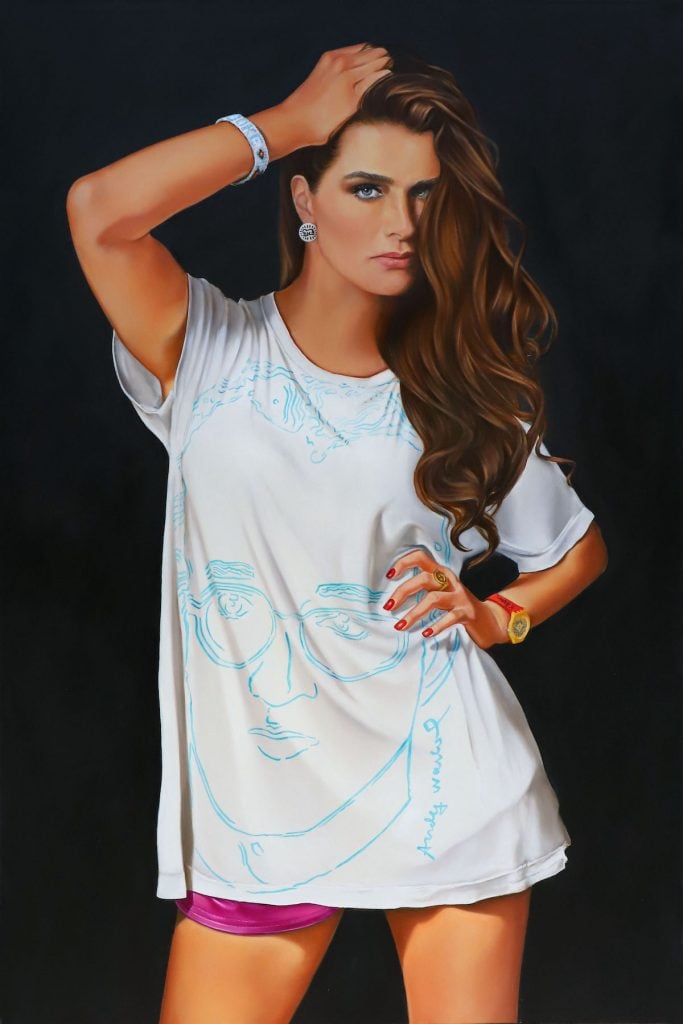
Tara Lewis, ’86 (2022). Courtesy of the artist and Louis K. Meisel Gallery.
You’ve modeled and posed for countless photographers, as well as painters. What do you think makes for a good collaboration between artists and muse?
I think things click when both sides come together to help manifest one vision. There’s a balance to it. Sometimes, in modeling, people just want you to act out or represent their vision, which is a different type of collaboration. But other times I can put on character clothing and act out scenarios and inhabit the character I want to be in that moment.
I read that when posing for Eric Fischl a few years back, you decided to play twin characters with different personalities via costuming choices. One twin was a quintessential Hamptons lady, the other a bit darker and unconventional. In posing for an artist what role does the costume or clothing play? Does it help you “become” a character?
For me, costuming is almost everything. It changes the way you hold your body, the way you walk, and even what you do with your hands. Makeup does a great deal too, but clothing is really the embodiment of who the character is. If I’m in a pencil skirt or a pair of overalls, my whole body morphs into an essence of a character. This is true of both still photography and painting.
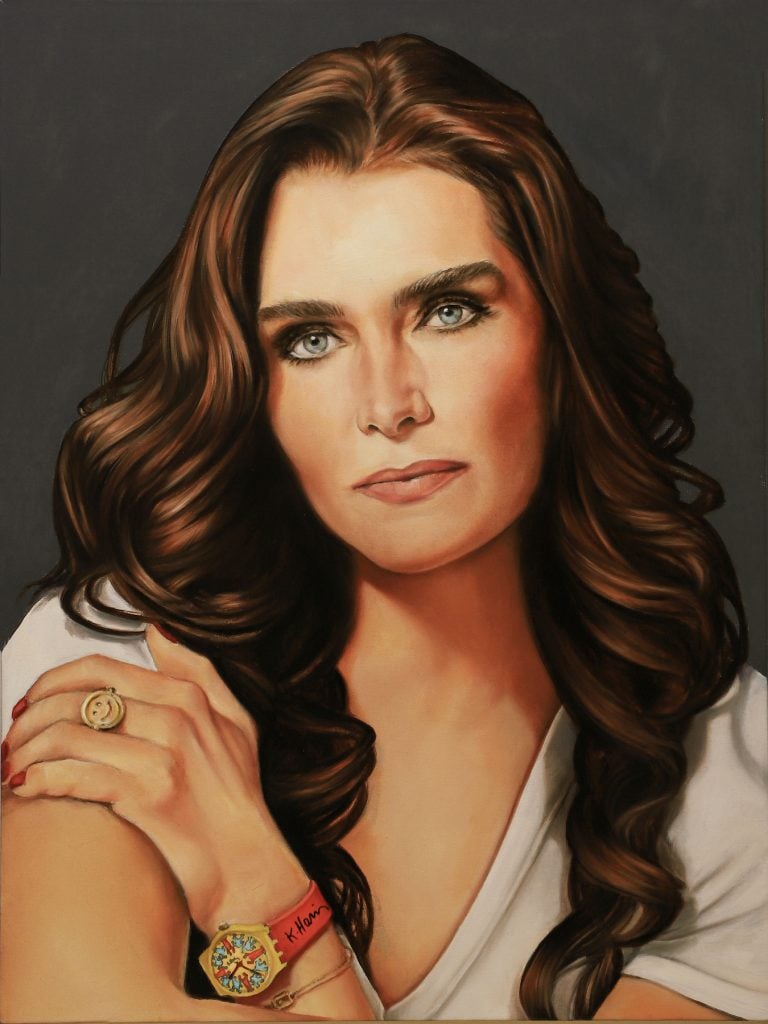
Tara Lewis, Brooke’s Swatch Watch (2022). Courtesy of the artist and Louis K. Meisel Gallery.
How did you first get connected with Tara Lewis?
I had seen her work randomly a few times. Her work comes through a lens of pop culture with a bit of a retro feel that she manages to make feel current. I found a contact number for Tara and basically cold-called her and said that I noticed her models seem to be people she knows and that my kids and I would definitely be willing to model for her if she was looking.
I’m on the board of the New York Academy of Art, and I’ve heard from artists that it’s harder than you think to find people to collaborate with and to sit for them. I had been surprised by that! Right away, Tara and I started brainstorming and talking about the ‘80s. I have kept so many pieces from that era that I’m proud I still have. Really precious items. My mom kept a lot that I’m grateful to have. They were right up Tara’s alley. I brought a whole bunch of props to her studio, including my two girls, and she had a whole table of various T-shirts and socks and roller skates and skateboards and all that kind of stuff. The girls and I were able to pick what we wanted. My youngest daughter did the makeup and we all did our own hair.
What are some of the props or clothing items you still have from the ‘80s that you brought with you to the studio?
I brought up a signed Swatch watch that Keith Herring gave me on my birthday. I also brought a T-shirt that has Keith’s face on it, which he’d given me from the Pop Shop, and some earrings and a smiley face ring and some other little items that were very important to me in that era. I even went into the archives and pulled out my very original Calvins.
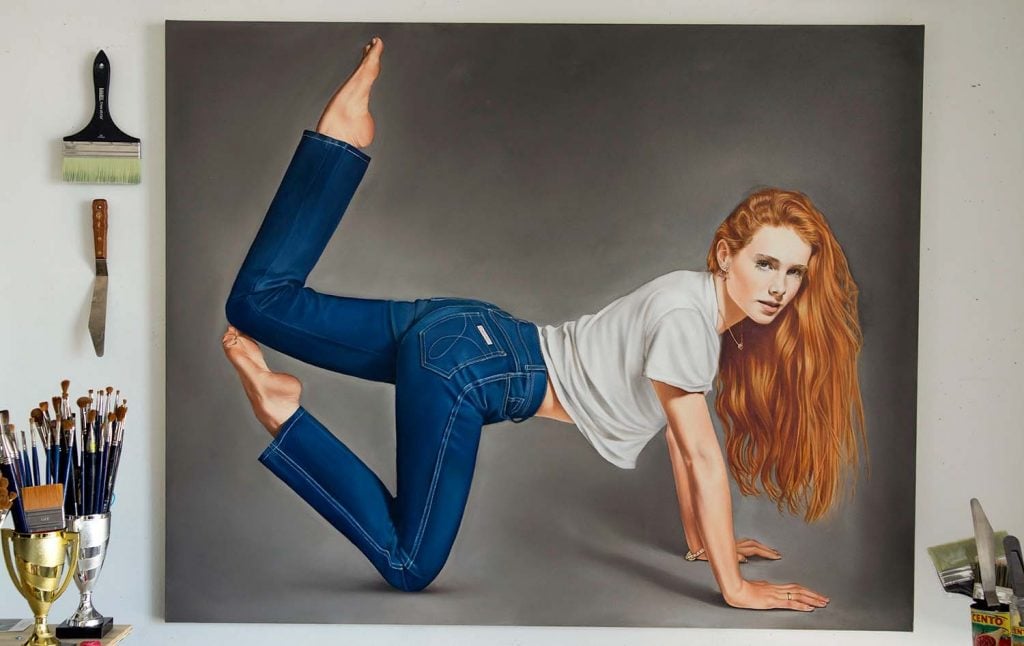
Tara Lewis, Survival of the Fittest (2020). Courtesy of the artist and Louis K. Meisel.
Oh, wow, the Calvins you wore in the famous ad?
Yes! I don’t fit in them anymore, but my 15-year-old does so she’s wearing them in one of Tara’s paintings, recreating a pose from that shoot.
In the 1980s you spent a lot of time in artistic circles and were friends with Andy Warhol and Keith Haring, who you mentioned. How did you fall into this circle?
It was really through my mom, who was always tapped into it. She had no education in the art world but she seemed to have a really good eye and zeroed in on Keith when he was first emerging in that scene. I went to high school on the East Side and we would drive past the Crack is Whack mural all the time. We were just a mother and daughter immersed in the cultural scene because we lived in Manhattan—all of our friends were photographers and artists and hairdressers and makeup artists. That was our circle. Artists always loved my mother because she was really beautiful and outgoing and so interested in the theater world and the art world. Art was an escape for her. She could look at paintings or movies she loved movies and escape into them.
I know you have a funny story about getting a birthday present from Keith Haring. Can you tell us the story?
Keith gave me a package for my 21st birthday which had everything imaginable from the Pop Shop and he had drawn on the outside of it. I, of course, went to go rip it open and my mother was like “No! Don’t! She took out a hairdryer and melted the tape because he had drawn on tissue paper, so it wasn’t on a sturdy paper. I still have it to this day. I’ll never get rid of it.
You were also close to Warhol. Is that how you became involved with the New York Academy of Art?
No, but I had always known about it, just from hearing him talk about the figure. As much of an icon of Pop Art as he was, his ideas were so rooted in figurative art and a belief that that’s the really arduous place where you need to start, where art can branch out from. My connection to the New York Academy of Art comes from Will Cotton, actually.
Oh, interesting. You have two portraits of your daughters by Will Cotton in your collection, I believe.
Yes, I had seen this Will Cotton drawing of a little girl with a cupcake on her head and I mentioned to a girlfriend that I would love to have a drawing of my girls like that. My friend is an art advisor and she suggested that I should look into it.
Well, I totally forgot about it. What I hadn’t known is she told my husband that I had expressed this love for his work, and so for our 10th anniversary, my husband got me two portraits of the girls by Will. It was amazing.
After meeting Will in person and talking, he suggested I come to a New York Academy of Art drawing party and talk. I immediately became enamored with the whole environment and became very close to the president, David Kratz, and his partner, Greg. We take all our family trips with them!
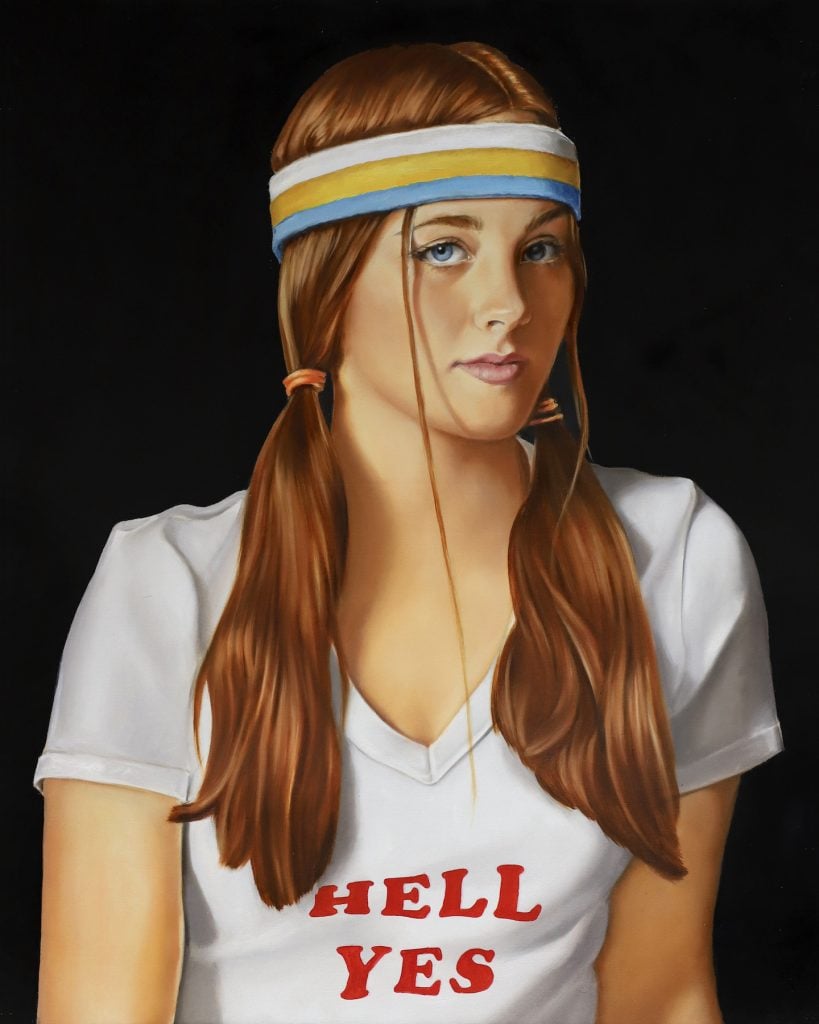
Tara Lewis, Hell Yes (2022). Courtesy of the artist and Louis K. Meisel Gallery.
In terms of your own collection, what draws you to a particular work?
I’ve always been drawn to figurative art… honestly, through my association with the Academy, I’ve become much more attuned to certain abstract works, which is a surprise to me because I’m just sort of classic in my taste. But I think my sense of humor has been able to come through in a lot of the pieces that buy. I buy mostly through the Academy and I always buy a work of art when I’m traveling, just exploring galleries, antique shops, or local stores on my own. Oftentimes, I only become aware of the artist’s story after I buy a painting. I don’t buy for any other reason other than what I want to live with. I don’t buy in the hope that the artist is going to become an investment. My tastes are really focused on individual works and finding a way to lose myself in it. I mean, you can look around my house and see how eclectic it is.
What does art mean to you and your life today?
After spending years listening to the students at the Academy and going into their studios, I admire the truth and pure talent of these artists. I marvel at it. I really appreciate the struggle and how hard they work and how supported they feel by one another. There are so few avenues of life that have not been completely tainted. It is a pleasure to see how brilliant people are and see how they strive.
Last question: Do you ever try painting or art-making yourself? Do you have any burgeoning artistic talents we need to know about?
None! I can do certain crafts. After I graduated from Princeton, I went back to study pottery and I did study it intensely for almost five years. Through that medium, I was able to find a creative outlet but when it came to any canvas or painting, I am not adept. My mom and dad both drew, but we all have our strengths and that’s okay!
